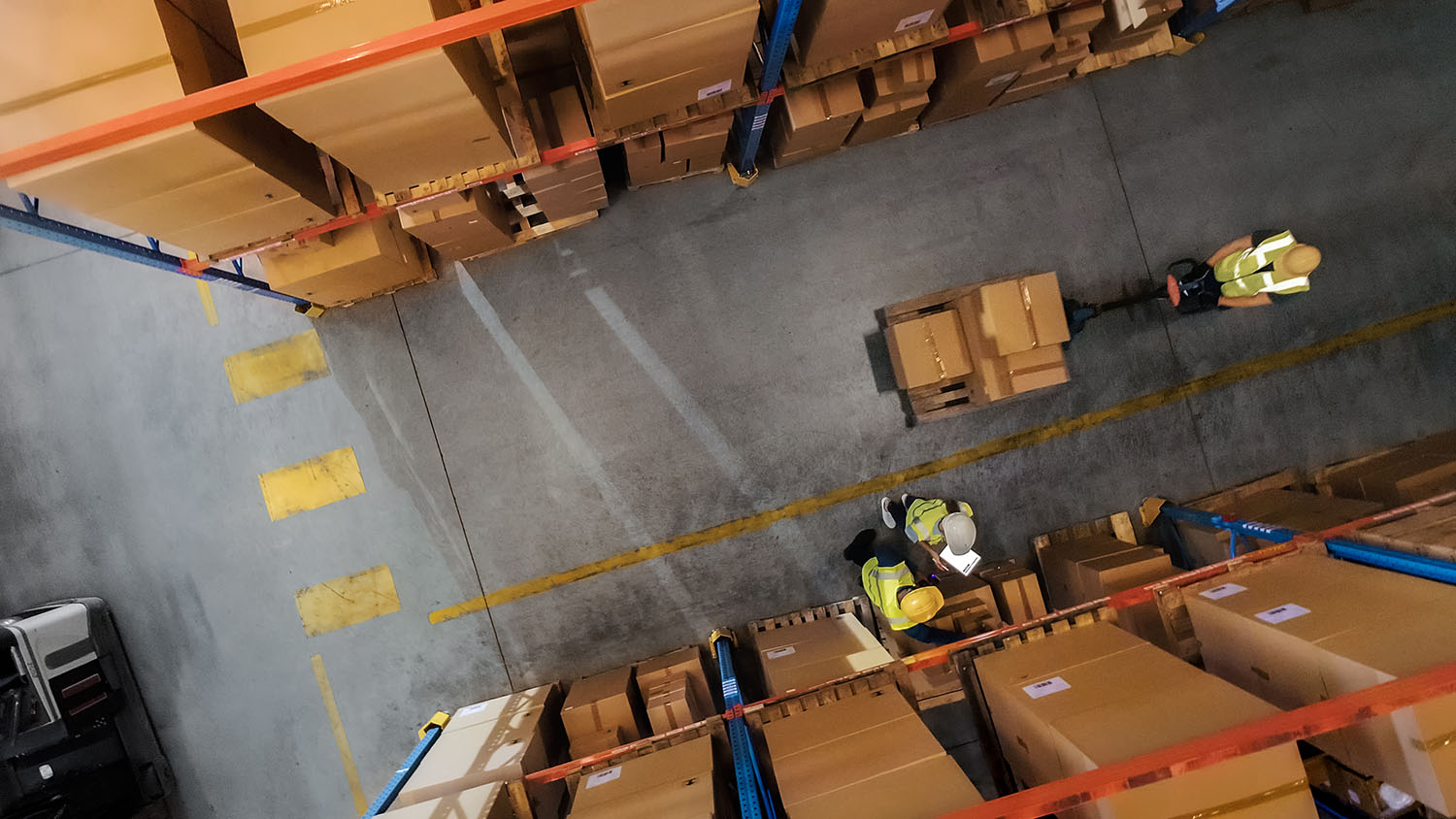Warehouse order picking is one of the most expensive and time-consuming processes in fulfillment.
Studies show that picking can account for up to 55% of total warehouse operating costs, making it a key area for optimization. And a major contributor to this inefficiency is unnecessary travel. Research from Veeqo found that pickers spend up to 60% of their time walking rather than actually picking items.
Pick path optimization solves this by determining the most efficient routes through a warehouse. Optimized paths help pickers reduce travel distances and complete orders faster.
Creating truly efficient pick routes isn’t as simple as taking the shortest path. It requires understanding different routing algorithms and how they apply to specific operations and warehouse layouts.
In this article, we’ll discuss the fundamentals of pick path optimization, the algorithms that power it, and practical strategies that can be implemented in real warehouse environments to achieve measurable efficiency gains.
What Is Pick Path Optimization?
Pick path optimization is the process of determining the most efficient routes for warehouse workers to retrieve items for order fulfillment. Instead of relying on manual or arbitrary picking paths, optimization ensures that pickers take the shortest, fastest, and most efficient route while avoiding congestion and unnecessary backtracking.
The difference is significant for large-scale operations. Amazon, for example, has optimized its fulfillment centers using advanced routing algorithms and robotics. A study published in the INFORMS Journal on Applied Analytics found that they reduced the distance traveled by robots per unit picked by 62% and cut the number of required robots by 31%, saving the company half a billion dollars.
So, pick path optimization isn’t just about shorter routes; it’s about smarter routes that consider warehouse layout, order demand, picking strategy, and the technology that powers them (more on all these later).
Why Pick Path Optimization Matters
With the e-commerce and retail fulfillment industries growing rapidly, warehouses that fail to optimize pick paths risk their business falling behind competitors that process orders faster and more accurately.
Let’s look at some of the key benefits of optimizing pick paths:
- Reduced Travel Time & Faster Order Fulfillment: Optimizing pick paths minimizes unnecessary movement and allows workers to retrieve items faster and process more orders in less time. This is especially useful for warehouses handling high order volumes or offering same-day delivery.
- Increased Margins: Labor is one of the biggest warehouse expenses, and every extra step a picker takes cuts into profitability. So by optimizing paths, fulfillment centers can scale operations without increasing staffing costs.
- Fewer Bottlenecks & Increased Accuracy: Inefficient paths cause congestion in busy aisles, slowing down operations and leading to picking errors. Smart routing distributes workload evenly, reduces traffic in high-density areas and ensures workers pick the right items in the right sequence.
- Improved Worker Productivity & Safety: Less walking and backtracking mean workers stay productive without unnecessary fatigue, which also reduces the chance of workplace accidents.
- Higher Throughput & Cost Savings: By reducing travel time and improving efficiency, warehouses can handle more orders per shift without increasing costs. Faster fulfillment speeds also mean fewer delays, fewer returns, and happier customers, improving profitability across the supply chain.
The Pick Path Optimization Algorithm
At its core, pick path optimization relies on mathematical algorithms to calculate the most efficient routes for warehouse pickers.
These algorithms analyze warehouse layouts, item locations, and order patterns to determine the shortest and most effective path while minimizing unnecessary travel.
The optimization process involves two key mathematical challenges:
- The Traveling Salesman Problem (TSP): Finding the most efficient sequence to visit multiple locations while covering the least distance.
- The Shortest Path Problem: Calculating the most efficient route between any two locations in your warehouse, accounting for factors like aisle width, obstacles, and distance. This is done via a weighted graph where each path has an assigned “cost” based on distance, travel time, or obstacles in your warehouse layout.
To solve these, warehouses use different algorithms depending on layout complexity, order volume, and available technology.
Key Algorithms for Optimal Pick Paths
Warehouse picking routes aren’t determined randomly. They’re optimized using advanced computational methods that balance efficiency and accuracy.
Below are the most commonly used algorithms in pick path optimization:
1. Dijkstra’s Algorithm (Shortest Path Optimization)
Dijkstra’s algorithm is one of the most widely used methods for finding the shortest route between two points. It calculates the fastest path while considering obstacles like shelf locations and warehouse congestion.
Use case: Best for structured warehouse layouts where pickers move along fixed paths without real-time changes.
2. A (A-Star) Algorithm (Advanced Route Planning)*
A* expands on Dijkstra’s by factoring in real-time constraints, such as traffic conditions or order priority. This makes it more effective for dynamic warehouse environments where paths might need to be adjusted based on live data.
Use case: Ideal for robotic picking systems or high-volume warehouses that need to continuously optimize picking routes.
3. Traveling Salesman Problem (TSP) & Christofides’ Algorithm
TSP determines the best order for picking multiple items while minimizing distance. Since calculating an exact solution can be too complex for large warehouses, a heuristic approach like Christofides’ Algorithm is often used. It guarantees a solution that’s at most 1.5 times the optimal distance.
Use case: Works best for batch picking, multi-order picking, and high-SKU warehouses where multiple items must be collected in one trip.
4. Ant Colony Optimization (ACO) Algorithm
Inspired by how ants find the shortest route to food, ACO simulates warehouse pickers learning from past movements. Routes that lead to faster picking times get reinforced, allowing AI-driven WMS platforms to optimize routes over time.
Use case: Ideal for AI-powered WMS solutions that track warehouse movements and improve pick path efficiency based on real-world data.
5. Cluster-Based & Wave Picking Algorithms
Instead of optimizing for a single order, these methods group orders into logical clusters or waves to minimize picker movement. They work well in warehouses where multiple orders share common SKUs.
Use case: Best for e-commerce fulfillment centers where orders with similar items are picked together for efficiency.
5 Best Strategies for Pick Path Optimization
Using the right algorithms is only part of the equation. Applying effective strategies ensures warehouses maximize efficiency and reduce picking time.
Here are some of the best strategies for optimizing pick paths:
1. Optimize Warehouse Layout
Poor warehouse layout is one of the biggest barriers to efficient picking. Even with the best algorithms, a disorganized warehouse leads to excessive travel time, congestion, and delays.
Optimizing the physical setup of the warehouse ensures that pickers move efficiently between storage locations.
Steps to Optimize Warehouse Layout:
- Store high-demand items closer to packing stations. This reduces the walking distance for pickers. In many e-commerce warehouses, the top 20% of SKUs account for 80% of orders (Pareto principle). Placing these items strategically improves efficiency.
- Use slotting optimization techniques. Position SKUs based on demand frequency and pick path efficiency. Place seasonal items in easy-access locations during peak times.
- Implement one-way aisles and logical zoning. Pickers should have a clear, structured flow without unnecessary backtracking. Design high-traffic areas to prevent congestion.
2. Use Batch, Zone, and Wave Picking
Traditional picking methods involve one order per trip, leading to excessive movement. Grouping orders and optimizing workflows significantly cuts down travel time.
Picking Methods Explained:
- Batch picking. Pickers collect multiple orders in a single trip, reducing back-and-forth travel. Best for warehouses processing multiple small orders with common SKUs.
- Zone picking. The warehouse is divided into sections, with each worker assigned to a specific zone. Orders are later consolidated. This prevents pickers from moving across long distances, improving efficiency.
- Wave picking. Orders are grouped into priority waves based on factors like shipping deadlines, SKU similarity, or order type. This allows simultaneous fulfillment of similar orders, reducing bottlenecks.
When to Use Each Method?
- Batch picking → Best for high-order-volume warehouses
- Zone picking → Ideal for large-scale operations with distributed SKUs
- Wave picking → Works well for e-commerce warehouses handling diverse order types
3. Implement Warehouse Management System (WMS) Technology
A WMS automates pick path optimization, reducing human errors and inefficiencies by generating real-time, data-driven picking routes.
Modern WMS solutions integrate AI, predictive analytics, and automation to create highly optimized workflows.
How WMS Improves Pick Path Optimization:
- Dynamic route adjustments. AI-driven WMS platforms reroute pickers in real time to avoid bottlenecks and congestion.
- SKU demand forecasting. The system predicts high-demand SKUs and recommends proactive slotting optimizations.
- Task assignment optimization. Instead of assigning picks manually, WMS distributes tasks efficiently among workers based on workload and proximity.
Pro Tip: Pairing WMS with pick-to-light and voice technology (covered in the next section) further enhances speed and accuracy.
4. Leverage Pick-to-Light and Voice Picking Technology
Traditional picking methods often rely on manual processes, increasing the risk of errors and inefficiencies. Technologies like pick-to-light and voice-guided picking help workers follow optimized pick paths with minimal mistakes.
How These Technologies Work:
- Pick-to-light systems. LED indicators highlight the exact shelf location of each item, reducing search time. Workers simply scan or confirm picks via a button press.
- Voice-guided picking. Pickers receive hands-free audio instructions, eliminating the need for printed lists or screens. The system adjusts instructions in real time based on order changes.
Warehouses using pick-to-light systems report a 30-50% improvement in picking speed. And warehouse using voice picking reduces error rates by up to 85% compared to paper-based picking.
5. Train Warehouse Staff on Efficient Picking Techniques
Even with automation and optimized layouts, human efficiency remains a key factor in pick path optimization. Well-trained pickers work faster, make fewer mistakes, and follow optimal routes instinctively.
Key Training Strategies:
- Teach pickers the logic behind efficient routes. Understanding why certain paths are more effective helps workers make better real-time decisions.
- Cross-train workers on multiple picking methods. Employees should be able to shift between batch, zone, and wave picking as needed.
- Monitor and improve individual performance. Use productivity tracking tools to identify inefficiencies and provide ongoing coaching.
Pro Tip: Gamifying performance metrics (e.g., leaderboards, incentives for top-performing pickers) boost engagement and encourages workers to follow optimized pick paths consistently.
Increase Warehouse Efficiency with Smarter Pick Paths
A few wasted steps might not seem like much—until you multiply them by hundreds of pickers and thousands of orders. That’s where pick path optimization makes all the difference. Cutting down travel time, using smarter algorithms, and adopting data-driven strategies can lead to faster fulfillment, increased margins, and fewer errors.
Da Vinci WMS offers advanced tools to streamline your warehouse operations. Key features include:
- Advanced Wave Picking Methods: Optimize order batching and minimize walking paths to enhance picking efficiency.
- Directed Putaway: Guide teams to optimal storage locations, maximizing space utilization and reducing handling time.
- Cartonization (Intelligent Auto-Packing): Determine the most efficient packing methods to optimize space usage and reduce shipping costs.
- Cart-Picking: Streamline the picking of multiple orders simultaneously, reducing travel time and increasing picker productivity.
- Cross Docking: Enable quick transfer of goods from inbound to outbound transportation, significantly reducing storage time and costs.
- Sophisticated 3PL Billing: Manage complex billing scenarios with precision, ensuring accuracy and efficiency in every transaction.
Want to see how Da Vinci Unified WMS can optimize your warehouse? Request a demo today and start making every step count.



